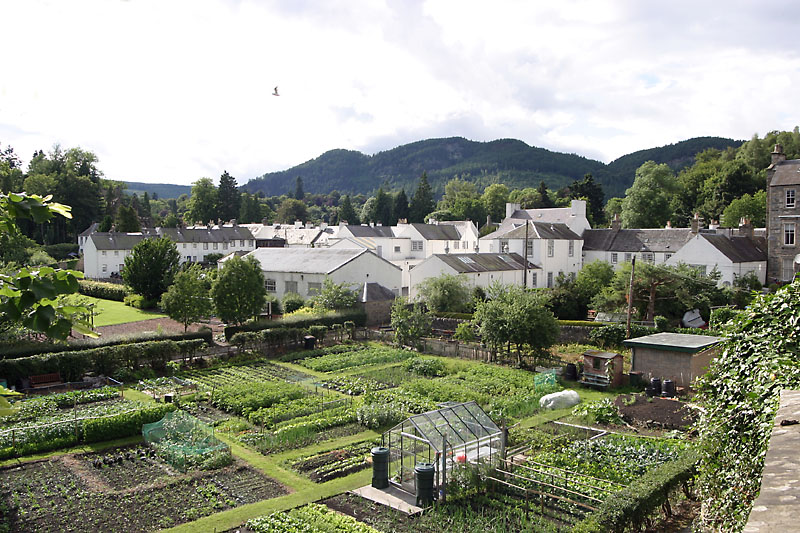Dunkeld
Situated a dozen miles from Perth and an almost equal distance from Pitlochry, Dunkeld was the first important ecclesiastical centre in Scotland. Best known for Dunkeld Cathedral, Dunkeld consists predominantly of charming 18th century architecture which will give you the impression that you have stepped back in time.
Way back in AD 843, Scotland's first king, Kenneth I chose Scone as his capital. Fearing another Viking attack, he removed St Columba's relics from Iona and placed them in the care of a Celtic Monastery at Dunkeld. The relics are now said to lie under the chancel steps of Dunkeld Cathedral. A most unusual building, Dunkeld Cathedral is part ruins and part parish church of Dunkeld - the 15th century nave is a ruins, the 14th century choir, the church. Although it was destroyed in the Reformation, Dunkeld Cathedral was restored in the 17th century. Dunkeld Cathedral is now full of historic relics including the tomb of Alexander Stewart. Better known as the Wolf of Badenoch, he is infamous for his sacrilegious sacking of Elgin Cathedral in the 14th century. In the Dunkeld Cathedral Museum you'll see a collection of early sculptured stones and the Atholl family memorial.
A seemingly tranquil place, Dunkeld has seen its fair share of Scotland's turbulent history. Following the destruction of Dunkeld Cathedral with the Reformation, the town of Dunkeld was actually turned into a battlefield in 1689. Following the parliamentarian removal of the Catholic Stuarts claim to the throne of England a year before, supporters of King James II known as the Jacobites rebelled throughout Scotland. However, the Battle of Dunkeld was unusually fought in the town itself. The Jacobites lost the battle and Dunkeld was left a total ruins.
Before the Battle of Dunkeld, the Dunkeld community was centred around Dunkeld Cathedral. However, as the Duke of Atholl preferred his new view of Dunkeld Cathedral, he ordered that the replacement buildings be built on the east side of the cathedral. Strolling through these 18th century streets with its whitewashed buildings is a thoroughly enjoyable way to see Dunkeld. Keep a look out for the Ell Shop, a National Trust building named after the ancient trading measurement the 'ell' (17 inches). The Ell Shop lies in a square familiarly known as the Cross. The cross was removed by the Duke of Atholl who replaced it with the fountain you'll see here on your visit. Behind the fountain is the very helpful Dunkeld Tourist Information Centre.
Way back in AD 843, Scotland's first king, Kenneth I chose Scone as his capital. Fearing another Viking attack, he removed St Columba's relics from Iona and placed them in the care of a Celtic Monastery at Dunkeld. The relics are now said to lie under the chancel steps of Dunkeld Cathedral. A most unusual building, Dunkeld Cathedral is part ruins and part parish church of Dunkeld - the 15th century nave is a ruins, the 14th century choir, the church. Although it was destroyed in the Reformation, Dunkeld Cathedral was restored in the 17th century. Dunkeld Cathedral is now full of historic relics including the tomb of Alexander Stewart. Better known as the Wolf of Badenoch, he is infamous for his sacrilegious sacking of Elgin Cathedral in the 14th century. In the Dunkeld Cathedral Museum you'll see a collection of early sculptured stones and the Atholl family memorial.
A seemingly tranquil place, Dunkeld has seen its fair share of Scotland's turbulent history. Following the destruction of Dunkeld Cathedral with the Reformation, the town of Dunkeld was actually turned into a battlefield in 1689. Following the parliamentarian removal of the Catholic Stuarts claim to the throne of England a year before, supporters of King James II known as the Jacobites rebelled throughout Scotland. However, the Battle of Dunkeld was unusually fought in the town itself. The Jacobites lost the battle and Dunkeld was left a total ruins.
Before the Battle of Dunkeld, the Dunkeld community was centred around Dunkeld Cathedral. However, as the Duke of Atholl preferred his new view of Dunkeld Cathedral, he ordered that the replacement buildings be built on the east side of the cathedral. Strolling through these 18th century streets with its whitewashed buildings is a thoroughly enjoyable way to see Dunkeld. Keep a look out for the Ell Shop, a National Trust building named after the ancient trading measurement the 'ell' (17 inches). The Ell Shop lies in a square familiarly known as the Cross. The cross was removed by the Duke of Atholl who replaced it with the fountain you'll see here on your visit. Behind the fountain is the very helpful Dunkeld Tourist Information Centre.
